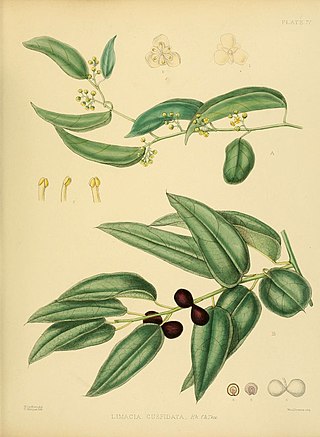
Menispermaceae is a family of flowering plants. The alkaloid tubocurarine, a neuromuscular blocker and the active ingredient in the 'tube curare' form of the dart poison curare, is derived from the South American liana Chondrodendron tomentosum. Several other South American genera belonging to the family have been used to prepare the 'pot' and 'calabash' forms of curare. The family contains 68 genera with some 440 species, which are distributed throughout low-lying tropical areas with some species present in temperate and arid regions.

Abuta is a genus in the flowering plant family Menispermaceae, of about 32 species, native to tropical Central and South America.

Odontocarya is a plant genus in the family Menispermaceae.
Rupert Charles Barneby was a British-born self-taught botanist whose primary specialty was the Fabaceae (Leguminosae), the pea family, but he also worked on Menispermaceae and numerous other groups. He was employed by the New York Botanical Garden from the 1950s until shortly before his death.

Cissampelos is a genus of flowering plants in the family Menispermaceae. Various species of this genus have a history of use in various traditions of herbal medicine. Moreover, many of these plants were used as curare applied as arrow poison during hunting.

Cissampelos pareira (velvetleaf) is a species of flowering plant in the family Menispermaceae.
Abuta is a plant genus in the family Menispermaceae.

Chondrodendron tomentosum is one of six accepted species in the small genus Chondrodendron, belonging to the Moonseed family Menispermaceae. It is a large tropical liana native to Central and South America. It contains highly toxic alkaloids and is one of the sources of the arrow poison curare - specifically 'tube curare', the name of which is derived from the name of the medicinally valuable alkaloid tubocurarine.
Curarea is a genus of flowering plants in the family Menispermaceae, found in tropical parts of Central and South America. They are dioecious lianas, with at least some species producing toxic compounds such as curare.
Caryomene is a genus of flowering plants belonging to the family Menispermaceae.
Chondrodendron is a genus of flowering plants belonging to the family Menispermaceae.
Diploclisia is a genus of flowering plants belonging to the family Menispermaceae.

Pachygone is a genus of flowering plants belonging to the family Menispermaceae.
Disciphania is a genus of flowering plants belonging to the family Menispermaceae.

Hypserpa is a genus of flowering plants belonging to the family Menispermaceae.
Orthomene is a genus of flowering plants belonging to the family Menispermaceae.
Sciadotenia is a genus of flowering plants belonging to the family Menispermaceae.
Elephantomene is a monotypic genus of flowering plants belonging to the family Menispermaceae. The only species is Elephantomene eburnea.
Abuta bullata is a species in the genus Abuta, which is part of the flowering plant family Menispermaceae. It is a perennial vine native to South America, particularly found in the Amazon rainforest. This species thrives in moist soils within the tropical and subtropical regions of the Amazon basin. It was first included in Brittonia in 1938.







